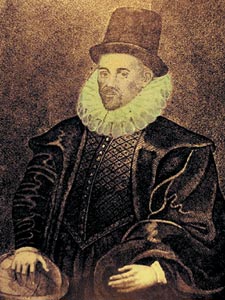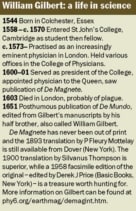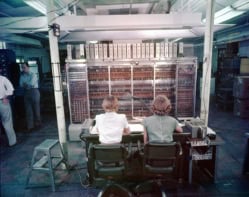The revolutionary thinker William Gilbert, who died 400 years ago this month, was largely responsible for creating the science of magnetism. David Tilley and Stephen Pumfrey believe that his achievements deserve to be much more widely recognized

When William Gilbert of Colchester died on 30 November 1603, England lost one of its greatest Elizabethan scientists. Three years earlier he had published a book called De Magnete, which was nothing less than the first ever work of experimental physics. Its fuller title, translated from the original Latin, was On the Magnet, Magnetic Bodies and that Great Magnet the Earth. In 1651 a collection of Gilbert’s manuscripts, which had been edited by his half brother, was posthumously published. Going under the title De Mundo Nostro Sublunari Philosophia Nova, the book provided “a new philosophy of our sublunary world”.
Despite the revolutionary nature of both of these works, Gilbert has in recent years sunk – quite unfairly we believe – into the footnotes of history. So why is his revolutionary achievement in creating the science of magnetism not better known?
A mind made for magnetism
Gilbert’s story began in Colchester, Essex, where he was born in 1544. He went up to Cambridge University at the age of 14, where he followed the standard undergraduate course of the day. It was here that he met, and subsequently rejected, the current scientific orthodoxy of Aristotle’s natural philosophy, Galen’s medicine and Ptolemy’s astronomy. The latter placed an immovable Earth at the centre of the universe, around which the planets and stars revolved in crystal spheres.
In contrast to the academic conservatism of Cambridge, Gilbert found in London – where he became a physician in the early 1570s – a booming centre of navigational expertise, technology and applied mathematics. Gilbert’s research into magnetism, as well as his medical practice, led him – unusually for the time – to seek out navigators and skilled instrument makers, collating their magnetic data and discoveries about lodestones and compass needles. Also in these circles were Copernicans who fuelled Gilbert’s then radical belief that the Earth was just one planet in an infinite universe.
Gilbert used his leisure and status as a court physician to launch his attack on traditional university science of the Earth by the publication of De Magnete in 1600. This single volume was organized into six separate books, each of which contained numerous chapters. The centrepiece was a hypothesis, which he had probably formed in the early 1580s, that the Earth is a giant magnet. Indeed, Gilbert had spent many years and much money – said to be £5000 – proving this hypothesis in a new, experimental way.
These experiments mainly involved using a spherical magnetic lodestone (known as a terella, or “little Earth”) and a freely pivoting miniature compass needle (or versorium). The London instrument maker Robert Norman had already discovered in 1581 that a standard compass needle points at a certain dip, or inclination, below the horizontal, in addition to pointing roughly north and south. However, he had no idea what this dip might be elsewhere on Earth. By studying how the dip of a versorium varies at different points around a terella, Gilbert successfully predicted that this relationship between dip and latitude on a terella models the dip of a compass needle around the Earth. In book 5 of De Magnete Gilbert was therefore able to propose a law for the dip of a compass needle at all points on the globe.
Nautical challenges
De Magnete also announced a new instrument called an inclinometer, with which navigators could keep a rough check on their latitude in cloudy weather. The instrument is illustrated in De Magnete, and several European sailors reported successful sea trials, although the technique ultimately proved of less use in practice.
A more ambitious scheme was to correlate longitude with “magnetic variation”, which is the deviation of magnetic north from true (astronomical) north. Unfortunately, this work foundered after the discovery in 1634 (inspired, ironically, by Gilbert’s research) of the time-dependence of this magnetic variation. This value was found to have decreased from 11° east of true north in 1580 to 4° east by 1634 – a discovery that shocked all European experts of the age.
Despite these subsequent setbacks, Gilbert’s navigational aims were endorsed by the mathematician Edward Wright in 1600 in his laudatory preface to De Magnete. “In truth, in my opinion,” he wrote, “there is no subject matter of higher importance or of greater utility to the human race.”
Gilbert carried out many other experiments, including the study of spherical lodestones that were floated on water in small wooden boats. This work showed that magnetic forces often produce circular motion, which led him to develop a magnetic cosmology of the rotating Earth. We now believe this cosmology was his main motivation for the study of magnetism.
Having shown that the Earth, which he called tellus or “Mother Earth”, has an immaterial magnetic force, Gilbert credited the Earth with a soul (anima) – then a common explanation for planets and other “self-moving” entities. In his view, the Earth’s magnetic soul rotated the planet around its axis, which was magnetically stabilized to a point near the Pole Star. Magnetism, in other words, caused the Earth’s Copernican diurnal rotation.
As Gilbert hinted in De Magnete (and expanded upon in De Mundo), he believed that animate forces of all the celestial bodies “conspired” dynamically to produce the regular but non-circular celestial motions. This first Copernican physics, elaborated in the final book of De Magnete and in De Mundo, was, of course, superseded some 80 years later by Newton’s work on gravitation. The grand aim of De Magnete – to take magnetism beyond the simple use of the compass to find north – was not as successful as Gilbert and Wright had hoped. His magnetic cosmology was also soon superseded. However, we do not believe that Gilbert’s contributions to navigation and to cosmology should simply be discounted. Gilbert’s magnetic Earth is the foundation of geomagnetism. He showed experimentally that magnetism involves a force at a distance, which encouraged other astronomers and physicists like Johann Kepler, Robert Hooke, Christopher Wren – and possibly Newton himself – to think of universal gravitation as analogous to magnetism.
Suppose, however, that we do discount the two grand aims of De Magnete and also ignore the chapters on navigation, practical instruments and on mathematical constructions, which might have been the work of his collaborator Edward Wright. Even then, in our view, the core that remains still stands as the first great work of experimental physics.
Consider the achievements that can undoubtedly be attributed to Gilbert at a time when the only magnetic materials known were lodestone (magnetite), iron and steel, and when the whole framework of modern science was still to be invented. The most famous, and rightly so, is his demonstration in De Magnete that the Earth is a great magnet. He showed this by means of what we would now call model experiments, including those on dip mentioned above, in which he showed that the behaviour of the versorium and terrella simulate that of the compass needle and the Earth.
Meanwhile, Gilbert’s qualitative discussion of magnetostatics is just about complete and carefully based in experiment. The direction of the internal field, the polarity of a cut magnet, as well as the processes of magnetization and demagnetization are all explored in detail. In chapter 11 of book 5, for example, Gilbert even comes close to the idea of a magnetic field and makes a very good shot at describing the dipolar field of the terrella. What is lacking is any attempt at the difficult problem of quantifying magnetic attractions beyond his comparisons of “weak” and “strong” lodestones.

The interaction between temperature and magnetism also receives penetrating and accurate discussion in several sections. The final main achievement is the account of electrostatics in a chapter of book 2 entitled “Of the attraction exerted by amber”. This appears partly to distinguish electric from magnetic effects, and establishes the very large number of “electrics”. Although Gilbert made no distinction between positive and negative charges – this would take another 150 years – this single chapter is still enough to have won him the title of “father of electrical science”.
When considering magnetism, the physicist and polymath William Whewell wrote in 1859: “Gilbert’s work contains all the fundamental facts of the science, so fully examined, indeed, that even at this day we have little to add to them.”
Gilbert’s deployment of experiment was deliberate, considered and groundbreaking. The first sentence of his preface starts: “In the discovery of secret things and in the investigation of hidden causes, stronger reasons are obtained from sure experiments and demonstrated arguments than from probable conjectures and the opinions of philosophical speculators of the common sort.”
The organization of De Magnete also has a very modern feel. Each topic is introduced by a careful review of previous work followed by an account of new experiments. Gilbert, however, was very much a man of his age in his mastery of invective. For example, when criticizing claims for magnetic perpetual-motion machines, he writes: “May the gods damn all such sham, pilfered, distorted works, which do but muddle the minds of students.”
Fallen star
Gilbert was more celebrated in his tercentenary year than he will be today. The great enthusiast Silvanus P Thompson was the leading light of the Gilbert Club, which found a considerable amount of new information on Gilbert. The members were perhaps not disinterested; the rising electric power industry could only benefit from acclaiming the eminent Englishman Dr Gilbert as the father of electrical science. Two translations of De Magnete appeared; although Thompson began first, he was pre-empted by P Fleury Mottelay’s 1893 edition.
Derek Price, who edited a 1958 reprint of Thompson’s Gilbert Club edition, eloquently describes Gilbert’s achievements. “One might well feel that Gilbert had invented the whole process of modern science rather than merely discovering the basic laws of magnetism and static electricity,” he writes. “Certainly he was the first to have the tenacity to work through a whole segment of physics methodically, appealing to experiment and reason throughout. Gilbert’s work formed the pattern for the subsequent treatment of other parts of physics, and much later for chemistry and biological subjects.”
Gilbert’s star has, however, fallen in recent decades for several reasons. It is not so fashionable to seek heroic ancestors. Historians, meanwhile, no longer see the scientific era of Gilbert, Kepler and Galileo as quite so “modern” and it is now impossible to dismiss Gilbert’s pre-modern hypotheses about the Earth’s and other planetary souls as irrelevant to his experiments. But the legacy of his magnetic science is still profound. Just look at De Magnete and judge this sharply written and profoundly innovative work for yourself.
- Both authors, together with the historian Nigel Goose, will be speaking at a day school about the life of Gilbert on 29 November in Colchester, organized by the Colchester Museums Service and the University of Essex




